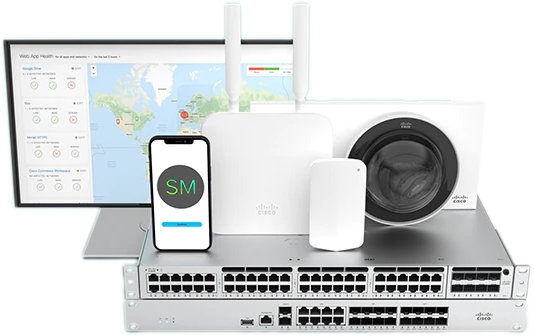 If your organization utilizes Meraki solutions, you need a valid license to keep them operational. You can either use them to add new products or renew your existing ones in your dashboard. Cisco offers flexible licensing options to suit your organizational needs. This article covers the two most popular and essential Meraki license types and their benefits to your business.
If your organization utilizes Meraki solutions, you need a valid license to keep them operational. You can either use them to add new products or renew your existing ones in your dashboard. Cisco offers flexible licensing options to suit your organizational needs. This article covers the two most popular and essential Meraki license types and their benefits to your business.
Per Device Licensing vs. Co-Termination
As the name insinuates, per-device licensing (PDL) offers flexibility for existing and new clients of all sizes. It allows the individual licensing of new devices, including access points (MR), managed network switches (MS), security firewalls & SD-WAN (MX), cameras (MV), and cellular gateways (MG). They can share an expiration date or have separate authorizations depending on the network or device.
Another aspect of PDL is a partial renewal for some devices. It’s also possible to move Meraki enterprise licenses between organizations without involving support. This functionality is accessible through the APIs and dashboard. Meraki offers a generous 90-day activation period, which allows enough time to deploy. Their APIs make it easier to assign, claim, and move licenses.
In case of a license expiry on a single device, Meraki will only stop supporting it after a 30-day grace period. The PDL licensing model is suitable if your organization has different budgets for various departments and associated devices. It's also preferable if you continually add new devices and different Meraki license types.
What Does Co-Term Licensing Entail?
The co-term model applies an organization-wide license and single expiration date to all Meraki devices. It does so by calculating the weighted average of the various Meraki license types on your cloud-managed dashboard. The expiration date dynamically changes with each new license claim.
For example, you might purchase three APs with different license periods. If one lasts five years (1,825 days) and the other two a year each (730 days total). Meraki will divide the absolute total (2,555 days) by three to arrive at a co-term licensing period of 851 days.
Similarities and Differences Between The Two Licensing Models
 Meraki's products maintain their high-quality core functionality whether you choose the PDL or co-term licensing option. However, some additional products, such as Umbrella, are only available with a per-device license. Other similarities between the licensing models include one Meraki license cost for devices and a unique license key for each order number. MX devices under both licensing models must also incorporate a company-wide Meraki Enterprise or Meraki Advanced Security license.
Meraki's products maintain their high-quality core functionality whether you choose the PDL or co-term licensing option. However, some additional products, such as Umbrella, are only available with a per-device license. Other similarities between the licensing models include one Meraki license cost for devices and a unique license key for each order number. MX devices under both licensing models must also incorporate a company-wide Meraki Enterprise or Meraki Advanced Security license.
The PDL model gives small businesses more flexibility. It's easier and more affordable to renew one device at a time compared to the entire cost of a co-term license. With PDL, Meraki only deactivates non-compliant devices. With co-term, an issue with one product can affect all devices on your dashboard. PDL also supports additional products such as Cisco Umbrella, which are not available in co-term licensing.
License More Devices vs. Renewal
If you're using a co-term licensing model, adding a new device also increases your entire organization's time limit. It adds the new device's period, then calculates a new weighted average for the co-term license.
A dashboard renewal is different in that it refreshes all listed devices, then extends your existing license. For instance, if you currently have 100 days remaining, a one-year dashboard renewal means the license expiration will now take effect after 465 days.
A dashboard renewal applies to the existing device count. Partial renewals don't work the same way as the add-a-new-device feature. For example, if your current license covers five APs and you decide to renew three, the new time limits will apply separately.
Final Thoughts
As a certified Cisco partner, Hummingbird Networks is conversant with all Meraki license types and their various dynamics. Our engineers and sales staff can advise on the best option for your business depending on your size, budget, and future needs. Contact our team of Meraki experts for a comprehensive explanation.









